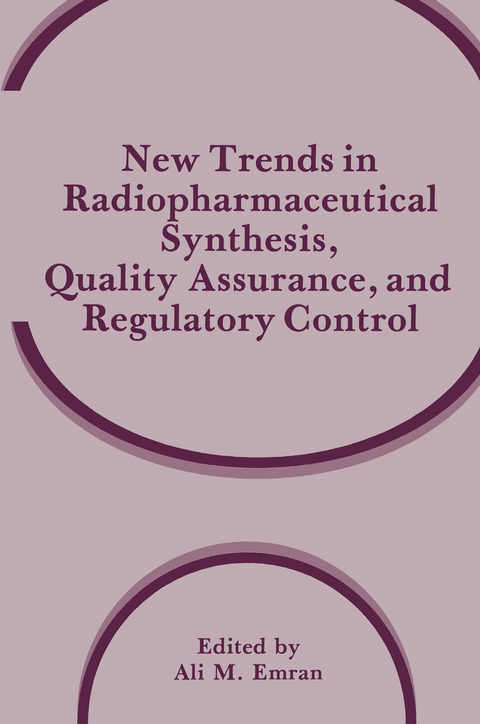
New Trends in Radiopharmaceutical Synthesis, Quality Assurance, and Regulatory Control
Kluwer Academic/Plenum Publishers (Verlag)
978-0-306-44035-9 (ISBN)
Marking the 200th National Meeting of the American Chemical Society, The Division of Nuclear Chemistry and Technology hosted a group of about 90 scientists from 15 different countries to discuss the new trends in radiopharmaceutical synthesis, quality assurance and regulatory control. This event took place in Washington, D.C. on August 27-30, 1990. When I first suggested the idea for this symposium, a group of scientists who pioneered the proposed topics offered their help to organize and run such a big task with me. Their names are listed here in appreciation. Thomas E. Boothe Cyclotron Facility, Mt. Sinai Medical Center, Miami Beach, Florida, USA Robert F. Dannals Division of Nuclear Medicine, The Johns Hopkins Medical Institutions, Baltimore, Maryland, USA Anthony L. Feliu Julich Nuclear Research Center, Julich, Germany Joanna S. Fowler Chemistry Department, Brookhaven National Laboratory, Upton, New York, USA George W. Kabalka Department of Chemistry, University of Tennessee, Knoxville, Tennessee, USA Hank F. Kung Department of Radiology, University of Pennsylvania, Philadelphia, Pennsylvania, USA James F. Lamb Imagents, Inc., Houston, Texas, USA Harold A. O'Brien, Jr. Los Alamos National Laboratory, Los Alamos, New Mexico, USA Joseph R. Peterson Dept. of Chemistry, University of Tennessee, Knoxville, Tennessee, USA Hernan Vera Ruiz International Atomic Energy Agency, Vienna, Austria Roy S. Tilbury University of Texas, M. D. Anderson Cancer Center, Houston, Texas, USA In addition, a number of distinguished colleagues have participated in the process of reviewing the manuscripts presented in this volume. Their effort is sincerely acknowledged.
1.1 Introductory Remarks.- 1.2 Overview.- 1.3 A Muscarinic Receptor Ligand: Review of the Chemistry and Applications.- 2.1 Aspects on the Synthesis and Design of 11C-Tracers for PET.- 2.2 Special Problems Associated with the Synthesis of High Specific Activity Carbon-11 Labeled Radiotracers.- 2.3 PET Radiopharmaceuticals via Reductive Carboxylation.- 2.4 [13N] Labeled Tracers, Synthesis and Applications.- 2.5 Cu1+ Assisted Nucleophilic Exchange Radiohalogenation: Application and Mechanistic Approach.- 2.6 Potential Breast Tumor Imaging Agents: Fluorotamoxifen and Derivatives.- 2.7 Fluorinated Azabicycloesters as Muscarinic Receptor Ligands for Application with PET.- 2.8 Flourine-18 Ligands for the In Vivo Study of ?-Adrenergic Receptors in the Heart and Lung.- 2.9 Design and Radiofluorination of Benzamide Dopamine D2 Receptor Ligands.- 3.1 A Synthetic Porphyrin with High Affinity for Lung Cancer Cells and Inflamed Lymphatic Tissue.- 3.2 Galium and Copper Radiopharmaceutical Chemistry.- 3.3 Radiometallating Antibodies and Autoantigenic Peptides.- 3.4 Biomedical Use of Arsenic Radioisotopes.- 3.5 Improved Extraction Efficiency of Gallium-67 After Irradiation of Zinc-68 with Protons.- 3.6 Chemistry and Concept for An Automated 72Se/72As Generator.- 3.7 Radiochemistry of Monoclonal Antibody Labeling.- 3.8 The Study on the Formulation of A Tc(V)-99m-DMS Lyophilized Instant Kit for Tumor Scintigraphy.- 3.9 A National Biomedical Tracer Facility.- 3.10 Tantalum-178-Labeled Radiopharmaceutical Synthesis Via The Intermediate Tantalum Pentachloride — A Potential Myocardial Perfusion Agent.- 3.11 Status of Lead and Bismuth for Radioimmunoimaging and Therapy.- 4.1 Use of Organolithium and Organomagnesium Reagents In Radiopharmaceutical Synthesis.- 4.2 Application of OrganosiliconChemistry to the Synthesis of Gamma and Positron Emitting Radiotracers for Use In Nuclear Imaging Studies.- 4.3 The Synthesis of Halogenated Radiopharmaceuticals using Organomercurials.- 4.4 Synthesis of Radiopharmaceuticals Via Organoboranes.- 4.5 Radiosotope Incorporation via Aryl and Alkenyl Trialkyltin Intermediates.- 5.1 Robots In the Radiopharmaceutical Laboratory: Will They Replace the Chemist?.- 5.2 The Use of Transducers for Automated Radiopharmaceutical Synthesis Procedures.- 5.3 Facilitating the Design and Operation of Computer-Controlled Radiochemistry Synthesizers with an “Electronic Toolbox”.- 5.4 Knowledge-Based Automated Radiopharmaceutical Manufacturing for Positron Emission Tomography.- 5.5 Robotic Thin Layer Chromatography Instrument for Synthetic Chemistry.- 5.6 Automated Radiochemical Processing for Clinical PET.- 5.7 Captive Solvent Methods for Fast, Simple, Carbon-11 Radioalkylation.- 6.1 Identity, Strength, Purity, Quality and Safety: Common Goals for New Drugs.- 6.2 Quality Assurance Considerations Related to “In-House” Radiopharmaceutical Preparations Utilizing Positron Emitting Radionuclides.- 6.3 The Role of High Performance Liquid Chromatography In Radiochemical/Radiopharmaceutical Synthesis and Quality Assurance.- 6.4 Experience from a National Quality Assurance System on Radiopharmaceuticals.- 6.5 Radiopharmaceutical Production for PET: Quality Assurance Practice, Experience and Issues.- 6.6 Post-Column Reactor Determination of Aluminum Concentration in Cyclotron Produced Radiorubidium.- 6.7 Implications of the Food, Drug and Cosmetic Act on the Quality Assurance of Radiopharmaceuticals used in the United States.- 6.8 Quality Assurance in Radiochemical/Radiopharmaceutical Manufacturing.- 7.1 Regulatory Control ofRadiopharmaceutics.- 7.2 Regulatory Control of Radiopharmaceuticals.- 7.3 Development of European Regulations on Radiopharmaceuticals.- 7.4 Regulation of Cyclotron Radiopharmaceutical Production and Distribution: An Agreement State Perspective.- 7.5 New Drug Approval Process for Radiopharmaceuticals.- 7.6 Abbreviated New Drug Applications (ANDAS): Future Trends in Radiopharmaceuticals.
| Erscheint lt. Verlag | 31.1.1992 |
|---|---|
| Zusatzinfo | XI, 520 p. |
| Verlagsort | New York |
| Sprache | englisch |
| Maße | 178 x 254 mm |
| Themenwelt | Medizin / Pharmazie ► Medizinische Fachgebiete ► Pharmakologie / Pharmakotherapie |
| Medizin / Pharmazie ► Pharmazie | |
| ISBN-10 | 0-306-44035-0 / 0306440350 |
| ISBN-13 | 978-0-306-44035-9 / 9780306440359 |
| Zustand | Neuware |
| Haben Sie eine Frage zum Produkt? |
aus dem Bereich


